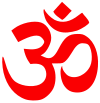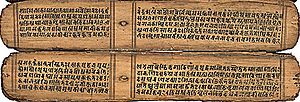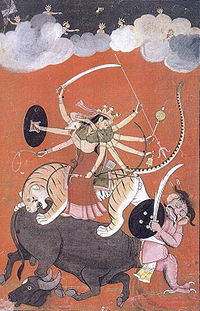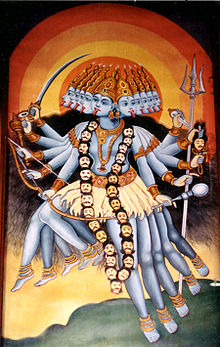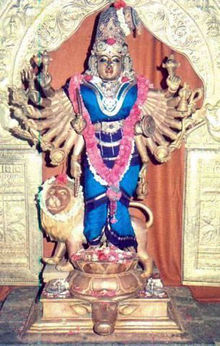- Devi Mahatmyam
-
Practices
The Devi Mahatmyam or Devi Mahatmya (Sanskrit: devīmāhātmyam, देवीमाहात्म्यम्), or "Glory of the Goddess") is a Hindu text describing the victory of the goddess Durga over the demon Mahishasura. As part of the Markandeya Purana, it is one of the Puranas or secondary Hindu scriptures, and was composed in Sanskrit around c. 400-500 CE, with authorship attributed to the sage (Rishi) Markandeya.
Devi Mahatmyam is also known as the Durgā Saptashatī (ढुर्गासप्तशती) or simply Saptashatī, Caṇḍī (चण्डी) or Caṇḍī Pāṭha (चण्डीपाठः) - where pāṭha – "reading" – refers to the act of ritual reading. The text contains 700 (saptashata - "seven hundred") verses, arranged into 13 chapters. By far the most important text of Shaktism,[1] the text has a central place in Shakta ritual.
Devi Mahatmyam is seen as an attempt to unify the Vedic male pantheon with the pre-existing mother goddess cult possibly dating to the 9th millennium BCE,[2] and an attempt to define divinity as a female principle. The text synthesizes a number of pre-existing Mother goddess myths of Aryan and non-Aryan origin into a single narrative.[3] The position of the Goddess as Shakti, power itself, beyond the patriarchal position as consort of an eclipsing male deity, is an important transition in Hindu mythology. Also, there are links to aspects of Samkhya philosophy in the narrative.
For ritual reading purposes a number of subsidiary texts are appended before and after. A ritual reading of this text is part of the Navaratri celebrations in honour of the Goddess. In eastern India, the ritual reading (chandipATh) is common at several functions, particularly in death rites. On Mahalaya, the last day of the previous fortnight Pitru Paksha (Pitri Pokkho), ‘Fortnight of the Forefathers’, recitation of Devi Mahatmyam (Chandi Path), and signifies the beginning of Durga Puja festivities. Bengalis traditionally wake up at 4 in the morning on Mahalaya day to listen to Mahisasura Mardini in the voice of the late Birendra Krishna Bhadra and the late Pankaj Kumar Mullick on All India Radio as they recite hymns from the scriptures.
Contents
Etymology
Sanskrit māhātmya- "magnanimity, highmindedness, majesty" is a neuter abstract noun of māha-ātman- "great soul". The title devīmāhātmyam is a tatpurusha compound, literally translating to "the magnanimity of the goddess".
The text is called Saptaśati as it contains 700 shlokas. (sapta=7,shata=100) verses. This count includes even one line sentences which are not strictly verses. There is another opinion that the name should be Saptasati as it deals with the story of seven Satis or "pious persons". The seven mothers are Brāhmi, Māheśwari, Kaumāri, Vaisṇavi, Vārāhi, Indrāṇi, and Cāmunḍa.[4]
Caṇḍī or Caṇḍīka is the name by which the Supreme Goddess is referred to in Devī Māhātmya. According to Coburn, "Caṇḍīkā is "the violent and impetuous one", from the adjective caṇḍa "fierce, violent, cruel". The epithet is unprecedented in Vedic literature and is first found in a late insertion to the Mahabharata, where Chaṇḍā and Chaṇḍī appear as epithets."[5]
Significance
The Devi Mahatmya was considered significant among the Puranas by Indologists. This is indicated by the early dates at which it was translated into European languages. It was translated into English in 1823, followed by an analysis with excerpts in French in 1824. It was translated into Latin in 1831 and Greek in 1853.[6]
Devi Mahatmya has been translated into most of the Indian languages. There are also a number of commentaries and ritual manuals. The commentaries and ritual manual followed vary from region to region depending on the tradition.
Place in the Hindu canon
Devi Māhātmyam has been called the Testament of Shakta philosophy[7] It is the base and root of Shakta doctrine.[8] It appears as the centre of the great Shakti cult.[9]
Devi portrayed as Mahishasura Mardini, Slayer of the Buffalo Demon – a central episode of the Devi Mahatmya
The Devi Mahatmya is not the earliest literary fragment attesting to the existence of devotion to a goddess figure, but it is surely the earliest in which the object of worship is conceptualized as Goddess, with a capital G.[10]
Here, for the first time, "the various mythic, cultic and theological elements relating to diverse female divinities were brought together in what has been called the 'crystallization of the Goddess tradition."[11]
The unique feature of Devi Māhātmyam is the oral tradition. Though it is part of the devotional tradition, it is in the rites of the Hindus that it plays an important role. The entire text is considered as one single Mantra and a collection of 700 Mantras.
The Devi Māhātmyam is treated in the cultic context as if it were a Vedic hymn or verse with sage(ṛṣi), meter, pradhnadevata, and viniyoga (for japa). It has been approached, both by Hindus and Western scholars, as scripture in and by itself, where its significance is intrinsic, not derived from its Puranic context.[12]
According to Damara Tantra "Like Aswamedha in Yagnas, Hari in Devas, Sapthsati is in hymns." "Like the Vedas; Saptasati is eternal" says Bhuvaneshwari Samhita.[13]
There are many commentaries on Devi Māhātmya. Santhanavi, Puspanjali, Ramashrami, Nagesi, Dhamsoddharam, Guptavati, and Durgapradeepam are some of them.[14] The significance of Devi Māhātmya has been explained in many Tantric and Puranic texts like Katyayani Tantra, Gataka Tantra, Krodha Tantra, Meru Tantram, Marisa Kalpam, Rudra Yamala, and Chidambara Rahasya.[14] A number of studies of Shaktism appreciate the seminal role of Devi Māhātmya in the development of the Shakta tradition.
Philosophy
Devi Mahatmya accepts the ancient Vedic tradition in the form of Vāk and Trayī Vidyā and the philosophical doctrine of the codified system of Samkhya (Prakriti manifesting as the three Gunas) and Vedānta as Paramavidyā, the cause of Mukti. Further it synthesizes the then prevailing local Mother goddess cults of Aryan and non-Aryan origin.[15]
In the first chapter it is said "all lives are conscious, but that knowledge is connected with senses. That goddess Bhagavatī, granting all kinds of prosperity, makes even the wise attracted to worldly pleasures and things forcibly with her great power of attraction. This ever-changing world with all its animate and inanimate things, is created by her. As the cause of salvation she turns into supreme spiritual knowledge, and is thus eternal; and again as the cause of bondage to worldly things she turns into things mundane and is the mistress of all, including Gods. She is eternal (and is thus beyond our knowledge) and pervades the world which may accordingly be called her form. Yet for the assistance of the lustrous souls, she appears in different forms."[16]
Though the figure of Siva is known in Devī Māhātmya the goddess bears no special relationship to him. In fact she bears no special relationship with anyone other than her devotees. While each God has a Sakti, Devī Māhātmya avoids characterizing such forms as consorts, for the Goddess is Sakti, power itself beyond the realm of being a consort to anyone. Devī Māhātmya does not know the conceptualization that Sakti is feminine and its possessor or vehicle masculine, for as it is seen, the Goddess herself can put forth a Sakti.[17]
Contents
The Devī Māhātmya consists of chapters 81-93 of the Mārkandeya Purana, one of the early Sanskrit Puranas, which is a set of stories being related by the sage Markandeya to Jaimini and his students (who are in the form of birds). The thirteen chapters of Devi Māhātmya are divided into three charitas or episodes. At the beginning of each episode a different presiding goddess is invoked, none of whom is mentioned in the text itself.[18]
The framing narrative of Devi Mahatmya presents a dispossessed king, a merchant betrayed by his family, and a sage whose teachings lead them both beyond existential suffering. The sage instructs by recounting three different epic battles between the Devi and various demonic adversaries (the three tales being governed by, respectively, Mahakali (Chapter 1), Mahalakshmi (Chapters 2-4) and Mahasaraswati (Chapters 5-13). Most famous is the story of Mahishasura Mardini – Devi as "Slayer of the Buffalo Demon" – one of the most ubiquitous images in Hindu art and sculpture, and a tale known almost universally in India. Among the important goddess forms the Devi Mahatmyam introduced into the Sanskritic mainstream are Kali and the Sapta-Matrika ("Seven Mothers").[19]
First Episode
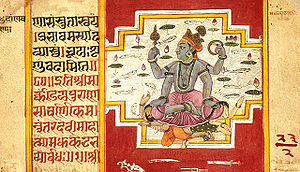 Vishnu killing Madhu-Kaitabh - a folio from Devi Mahatmya
Vishnu killing Madhu-Kaitabh - a folio from Devi Mahatmya
The first story of the Devi Mahatmya depicts Devi in her universal form as Shakti. Here Devi is central and key to the creation myth; she is the power that induces Vishnu's deep slumber on the waters of the cosmic ocean prior to the manifestation of the Universe which is a continuous cycle of manifestation, destruction and re-manifestation. Vishnu reclines on the nāga shesha during yoganidra. Two demons arise as thoughtforms from Vishnu's sleeping body and endeavour to vanquish Brahma who is preparing to create the next cycle of the Universe. Brahma sings to the Great Goddess, asking her to withdraw from Vishnu so he may awaken and slay the demons. Devi agrees to withdraw and Vishnu awakens and vanquishes the demons. Here Devi serves as the agent who allows the cosmic order to be restored.[20]
Middle Episode
"Durga, the great Warrior Goddess, represents the lethal energy of divine anger when turned against evil. The world was under attack by Mahishasura, the most evil demon in the world, who took many different forms, including that of a buffalo. The male gods, fearing total annihilation endowed Durga with their powers. Riding a lion into battle, Durga slew the buffalo by cutting off its head and then she destroyed the spirit of the demon as it emerged from the buffalo's severed neck. It is through this act that order was established in the world."[21]
 The Goddess Ambika or Durga Leading the Eight Matrikas in Battle Against the Demon Raktabija, Folio from a Devi Mahatmya - (top row, from the left) the Matrikas - Narashmi, Vaishnavi, Kumari, Maheshvari, Brahmi. (bottom row, from left) Varahi, Aindri, Chamunda or Kali(drinking the demon's blood), Ambika. on the right, demons arising from Raktabija's blood
The Goddess Ambika or Durga Leading the Eight Matrikas in Battle Against the Demon Raktabija, Folio from a Devi Mahatmya - (top row, from the left) the Matrikas - Narashmi, Vaishnavi, Kumari, Maheshvari, Brahmi. (bottom row, from left) Varahi, Aindri, Chamunda or Kali(drinking the demon's blood), Ambika. on the right, demons arising from Raktabija's blood
Final Episode
Kali may be understood to represent or "aspect" the darker, chthonic, transformative qualities of Devi's power or Shakti. Kali's emergence is chronicled in the third story of the Devi Mahatmya. Kali emerges from Devi's third eye as a burst of psychic energy. Kali overpowers and beheads Chanda and Munda, and when she delivers their severed heads to Devi, she is dubbed Chamunda.
During a fierce battle in which the Great Goddess demonstrates her omnipotence by defeating powerful demons who terrify the devas, she encounters the fierce Raktabija (chapter 8). Every drop of blood Raktabija sheds transforms into another demon as it touches the earth. A unique strategy has to be devised to vanquish him. A fiery burst of energy emerging from Devi's third eye takes the dark skeletal form of goddess Kali. With her huge mouth and enormous tongue she ferociously laps up Raktabija's blood, thus preventing the uprising of further demons.
The story continues in which Devi, Kali and a group of Matrikas destroy the demonic brothers Sumbha (chapter 10) and Nisumbha (chapter 9). In the final battle against Shumbha, Devi absorbs Kali and the matrikas and stands alone for the final battle.[21]
Symbolism of the three episodes
Coburn says: "The sage's three tales are allegories of outer and inner experience, symbolized by the fierce battles the all-powerful Devi wages against throngs of demonic foes. Her adversaries represent the all-too-human impulses arising from the pursuit of power, possessions and pleasure, and from illusions of self-importance. Like the battlefield of the Bhagavad Gita, the Devi Mahatmya's killing grounds represent the field of human consciousness ... The Devi, personified as one supreme Goddess and many goddesses, confronts the demons of ego and dispels our mistaken idea of who we are, for – paradoxically – it is she who creates the misunderstanding in the first place, and she alone who awakens us to our true being."[22] Chapter 1, Chapter 4 , chapter 5, chapter 11 describe the praise given to the great Goddess Mahakali yognindra, Goddess Chandi, who slayed Mahishasura , Goddess Adi-Shakti or Parvati, the one who is source of all other Goddesses and power inside all gods and Goddess Durga, who was born from the partial expansion of the Goddess Parvati respectively declares that Goddess Adi-shakti is Supreme of all and source of all creation. In chapter 1, Lord Brahma even praises that the great Goddess has created everything including himself, Vishnu and Shiva.[23]
Hymns
Coburn has said:
"While, in terms of quantity of verses, the Goddess's martial exploits are predominant, in terms of quality, these are surpassed by verses of another genre, viz., the hymns to the Goddess. Much of the power of the Devī Māhātmya derives from the way in which the hymnic material is held in counterpoint to the discursive account of her salvific activity in the world, but to the reader-hearer it is clear that the devotional fervor of the text, and the synthetic work it is performing, emerge most intensely in the hymns."[24]
The four Hymns are:
- Brahma-stuti also known as Tantrik Ratri Suktam (Chapter 1): In the first episode, when Brahma hymns Yoganidra, requesting her withdrawal from Vishnu so that he can slay Madhu and Kaitaba.[25]
- Sakradi-stuti (Chapter 4): At the end of second episode, after the Goddess has vanquished demon Mahishasura and his hordes, the Gods with first god Indra , praise her.[26]
- The "Ya Devi" Hymn also known as Aparajita-stuti or Tantrik Devi Suktam (Chapter 5): At the beginning of the third episode, when the beleaguered gods recall the Goddess's promise to assist them, they head to Mount Himavan and there offer a hymn to the Goddess.[27]
- Narayani-stuti (Chapter 11): At the conclusion of the third episode, after the Goddess has disposed of Sumbha and Nisumbha, she is hymned by the Gods.[28]
Angās (Appendages)
As an independent text, Devī Māhātmya has acquired a number of "limbs" or "subsidiary texts" or "appendages" (angas) over the years "fore and aft". According to Coburn "artistic evidence suggests that the angas have been associated with the text since the fourteenth century." The angas are chiefly concerned with the ritual use of Devī Māhātmya and based on the assumption that the text will be recited aloud in the presence of images.[29]
There are two different traditions in the Anga parayana. One is the trayanga parayana (Kavacha, Argala,Keelaka). The other is the Navanga parayana (Nyasam, Avahanam, Namani, Argalam, Keelakam, Hrudayam, Dhalam, Dhyanam, Kavacham). The navanga format is followed in kerala and some other parts in South India.
Preceding subsidiary texts
- Durga Saptasloki also known as "Amba Stuti" - They are introduced as one-verse query from Siva who asks about the means of achieving what is desired, and a one verse response from the Goddess who says she will proclaim the relevant discipline (sadhana) by revealing Amba Studi which consists of the seven verses indicated.[30]
- Devi-kavacham - The Devi Kavacham consisting of 61 Slokas is in Markandeya Purana. This Kavacham (armour) protects the reader in all parts of his body, in all places and in all difficulties.[31]
- Argala-stotram - Here Rishi Markandeya is telling his disciples in 27 inspiring couplets on the greatness of Devi. She has been described in all aspects and names and at the end of each Sloka, prayer is offered to Devi for material prosperity, physical fitness, fame and victory.[31]
- Keelakam - Here also Rishi Markandeya tells his disciples in 16 Slokas, the ways and means of removing obstacles faced by devotees, while reading Devi Mahatmya.[31]
- Ratri Suktam (Vedic) - Ratri Suktam (8 Slokas) has been taken from Rig Veda, 10th Mandala, 10th Anuvaka, 127 th Sukta,which shows that Devi was worshipped from time immemorial. Devi is described as the all-pervading Supreme Lord of the Universe appearing in Omkara. Here Ratri is the Goddess who fulfills our prayers.[31]
- Kunjika Stotram is also a beautiful hymn written in the saptashati which is said to be the mixture of the three hymns ie,Kavacham,Argala stotram,Keelakam and also Rahasya parvam (Murthy Rahasyam and Vaikrutika Rahasyam).It is said that Lord Shiva had recieted this shloka to Parvathi at her attainment of BramhaGyaan. This shloka plays an importantrole in Devi Saptashati. It is at the ending of the book.
- Ratri Suktam (Tantrik) - The hymn in the first chapter is the Tantrik Ratri Sukta.[32]
Either the Ratri Suktam (Vedic) or Ratri Suktam (Tantrik) is read depending upon whether the ritual is Vaidic or Tantrik.
One of the texts recited by some traditions is the Devī-Atharva-Śirṣa-Upaniṣad (Devi Upaniṣad).
Succeeding subsidiary texts
- Pradhana Rahasyam - "Deals with the process of creation. It is the secret about mula Prakrti who is the cause of creation."[33]
- Vaikritika Rahasyam - "Describes how the Godhead beyond change subjected itself to change, how the mula prakrti (productive) ,became vikriti (produced); hence the name Vaikritika Rahasyam."[33]
- Murti Rahasyam - "The incarnations, the Avatar murtis of the Goddess are mentioned."[33]
- Devi Suktam (Rig Vedoktam) - (According to Rig Veda): "The 8 Slokas composed by Vak, the daughter of Maharshi Ambharin, are from the Rig Veda, 10th Mandala, 10th Anuvaka, 125th Sukta. These Slokas express the truth realised by Vak, who identifies herself as Brahma Sakti, and expresses herself as 11 Rudras, 8 Vasus, 12 Adityas and all the Devas,— Indra, Agni and Asvini Kumaras—who are sustained by Her and She is the source, substratum and support of the whole world. She is verily Brahmasvarupini (embodiment of Brahman)."[31]
- Devi Suktam (Tantrik) - The hymn in chapter 5 is Tantrik Devi Suktam.[32]
The number and order of these depend on the Sampradaya (tradition).[34][35]
Either the Devi Suktam (Vedic) or Devi Suktam (Tantrik) is read depending upon whether the ritual is Vedic or Tantrik.
At the end of a traditional recitation of the text, a prayer craving pardon from the Goddess known as Aparadha Kshmapana Stotram is recited.
Mantra
Bhāskararāya in his commentary "Guptavatīi" has noted that, among the mantras related to the worship of Brahman cum Sakthi with attributes, the Navārna mantra and Saptasati are preeminent. Saptasati here is understood as constituting one very long mantra. Navārna mantra has been explained in Devī-Atharva-Śirṣa-Upaniṣad (Devi Upaniṣad).[36]
The Navārna Mantra is also known as Chandi or Navakshari (the one with nine-syllables).
The mantra is:
oṁ aiṁ hrīṁ klīṁ cāmuṇḍayāi viche
ॐ ऐं ह्रीं क्लीं चामुण्डायै विच्चेThe Navārna mantra is recited before and after the recitation of Devī Māhātmya.
In popular tradition
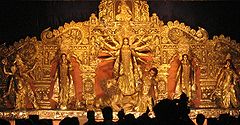 Recitation of Durga Mahatmya on Mahalaya marks the formal beginning of the Durga Puja festival
Recitation of Durga Mahatmya on Mahalaya marks the formal beginning of the Durga Puja festival
The recitation of Devi Mahatmya is done during the Sharad Navaratri (Oct. - Nov.) in India, other countries in Indian Subcontinent and all over the world where Hindus are settled. The text is also recited during the Vasantha Navaratri (March - April) in Uttarakhand, Kashmir, Himachal Pradesh and other states of north India.[1][2]
Devi Mahatmya is the ritual text for performing Chandi Yajna . This is one of the most popular Yagnas conducted throughout India. This is performed for the general welfare of the people.[3]
See also
Notes
- ^ Narayanan, Renuka, "To Devi, who abides in all beings as strength...', Hindustan Times, October 13, 2007.
Refers to the Devimahatmyam as the "Shakta Bible" - ^ Kali, Davadatta (translator and commentator) (2003). Devimahatyam: In praise of the Goddess. Motilal Banarsidass.
- ^ *Swami Jagadiswarananda, Devi Māhātmyam. p vi
- ^ Sankaranarayanan, p 7
- ^ Coburn, Thomas B., Devī Māhātmya. p 95
- ^ Coburn, Thomas B., Devī Māhātmya. p 52
- ^ Manna, Sibendu, p 92
- ^ Swami Sivananda p 5
- ^ Coburn, Thomas B., Devī Māhātmya. p 55
- ^ Coburn, Thomas B., Encountering the Goddess.
- ^ Brown, C. MacKenzie, The Triumph of the Goddess
- ^ Coburn, Thomas B., Devī Māhātmya. p 51–55
- ^ Anna, p vii
- ^ a b Anna, p v
- ^ Goyal S.R., p 295
- ^ Goyal S.R., p 297
- ^ Coburn, Thomas B., Devī Māhātmya. p 308–309
- ^ Coburn, Thomas B., Encountering the Goddess. p 100
- ^ Kali, Davadatta, p. xvii
- ^ "Devi". http://www.asia.si.edu/devi/creation.htm.
- ^ a b "Devi". http://www.asia.si.edu/devi/text2.htm.
- ^ Coburn, Thomas B., Encountering the Goddess
- ^ Durga Saptashati
- ^ Coburn, Thomas B., Devī Māhātmya. p 72
- ^ Coburn, Thomas B., Devī Māhātmya. p 290
- ^ Coburn, Thomas B., Devī Māhātmya. p 291
- ^ Coburn, Thomas B., Devī Māhātmya. p 295
- ^ Coburn, Thomas B., Devī Māhātmya. p 298
- ^ Coburn, Thomas B., Encountering the Goddess.p 100–101
- ^ Coburn, Thomas B., Encountering the Goddess.p 223
- ^ a b c d e Swami Sivananda, p 3
- ^ a b Swami Satyananda Saraswati, Chaṇḍī Pāṭh
- ^ a b c Sankaranarayanan. S., p 271–273
- ^ Sarma, Sarayu Prasad, Saptashatī Sarvasvam
- ^ Sri Durga Saptashatī, Gita Press
- ^ Coburn, Thomas B., Encountering the Goddess, p 136
References
- Anna, Sri. Devi Māhātmyam with commentary in Tamil, Sri Ramakrishna Matam, Chennai, India, 1973. (ISBN 81-7120-128-8)
- Brown, C. MacKenzie, The Triumph of the Goddess: The Canonical Models and Theological Issues of the Devi-Bhagavata Purana. State University of New York Press (Suny Series in Hindu Studies, 1991). (ISBN 0791403637)
- Coburn, Thomas B., Encountering the Goddess: A translation of the Devi-Mahatmya and a Study of Its Interpretation. State University of New York Press, 1991. (ISBN 0791404463)
- Coburn, Thomas B., Devī Māhātmya, The Crystallization of the Goddess Tradition. South Asia Books, 2002. (ISBN 81-208-0557-7)
- Goyal S.R., A religious History of Ancient India, Volume Two, Kusumanjali Prakashan, Meerut, India, 1986.
- Kali, Davadatta, In Praise of the Goddess: The Devimahatmya and Its Meaning. Nicolas-Hays, Inc., Berwick, Maine, 2003. (ISBN 8120829530)
- Manna, Sibendu, Mother Goddess, Chaṇḍī, Punthi Pustak, Calcutta, India, 1993. (ISBN 81-85094-60-8)
- Sankaranarayanan, S., Glory of the Divine Mother (Devī Māhātmyam), Nesma Books, India, 2001. (ISBN 81-87936-00-2)
- Sarma, Sarayu Prasad, Saptashatī Sarvasvam, in Sanskrit, - A cyclopaedic work on Devī Māhātmya. Rashtriya Sanskrita Samsthan, New Delhi, India, 2006.
- Sri Durga Saptashatī, - Original text and ritual manual with Hindi translation, Gita Press, Gorakpur, India.
- Swami Jagadiswarananda, Devi Māhātmyam English translation, Sri Ramkrishna Math, Madras, 1953. (ISBN 978-8171201396)
- Swami Satyananda Saraswati, Chaṇḍī Pāṭh, Devi Mandir Publications, USA and Motilal Banarsidass Publishers Pvt. Ltd., Delhi, India, 1995. (ISBN 81-208-1307-3)
- Swami Sivananda, Devi Māhātmya (with a lucid running translation), The Divine Life Society, Shivanandanagar, India, 1994. (ISBN 81-7052-103-3)
Further reading
- Coburn, Thomas B. Encountering the Goddess A Translation of the Devī-Māhātmya and a Study of Its Interpretation. SUNY series in Hindu studies. Albany, N.Y.: State University of New York Press, 1991. ISBN 0791404455
- Hiltebeitel, Alf, and Kathleen M. Erndl. Is the Goddess a Feminist? The Politics of South Asian Goddesses. New York: New York University Press, 2000. ISBN 0814736181
- Jyotir Maya Nanda. Mysticism of the Devi Mahatmya Worship of the Divine Mother. South Miami, Fla: Yoga Research Foundation, 1994. ISBN 0934664587
External links
- Devī Māhātmya - Sanskrit original in pdf form.
- Devī Māhātmya by Swami Sivananda at Divine Life Society
- Devi Mandir - About recitation of Chandi Path.
- The Esoteric Significance of the Devī Māhātmya
- Durga Saptashati
- Sāṅkhya-Internet Encyclopedia of Philosophy
- Durga Saptashati - Hindi verses
- in Sanskrit Verses (also in English Rhyme)
- Lokakshema Yagna Trust - Charitable spiritual organization performing Chandi Yagnas
- Shree Durga Sapta Shati - Video with meanings explained in Hindi
Categories:- Hindu texts
- Shaktism
- Sanskrit words and phrases
- Durga Puja
Wikimedia Foundation. 2010.

